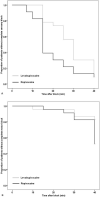Comparison of the onset time between 0.375% ropivacaine and 0.25% levobupivacaine for ultrasound-guided infraclavicular brachial plexus block: a randomized-controlled trial
- PMID: 33633231
- PMCID: PMC7907375
- DOI: 10.1038/s41598-021-84172-2
Comparison of the onset time between 0.375% ropivacaine and 0.25% levobupivacaine for ultrasound-guided infraclavicular brachial plexus block: a randomized-controlled trial
Abstract
At centers with pressure on rapid operating room turnover, onset time is one of the important considerations for choosing a local anesthetic drug. To hasten the onset of the block, higher concentrations of local anesthetics are sometimes used. However, the use of diluted local anesthetics may be safer. Therefore, we aimed to compare the onset times of equipotential levobupivacaine and ropivacaine at low concentrations for infraclavicular brachial plexus block. Adult patients undergoing upper extremity surgery under ultrasound-guided infraclavicular brachial plexus block at our center were randomly allocated to the levobupivacaine and ropivacaine groups. Infraclavicular brachial plexus block was induced with 0.25% levobupivacaine or 0.375% ropivacaine depending on the assigned group. The degrees of sensory and motor blockade were assessed for 40 min after the administration of local anesthetics. A total of 46 patients were included in the analysis. Infraclavicular brachial plexus block with 0.25% levobupivacaine and 0.375% ropivacaine provided sufficient surgical anesthesia. The sensory onset time of 0.375% ropivacaine was shorter than that of 0.25% levobupivacaine (group R, 15 [15.0-22.5] min; group L, 30 [17.5-35.0] min, p = 0.001). There were no significant differences in other block characteristics and clinical outcomes between the two groups. Thus, when a quicker block onset is required, 0.375% ropivacaine is a better choice than 0.25% levobupivacaine.Trial registration ClinicalTrials.gov (NCT03679897).
Conflict of interest statement
The authors declare no competing interests.
Figures


Similar articles
-
Postoperative analgesia comparing levobupivacaine and ropivacaine for brachial plexus block: A randomized prospective trial.Medicine (Baltimore). 2017 Mar;96(12):e6457. doi: 10.1097/MD.0000000000006457. Medicine (Baltimore). 2017. PMID: 28328862 Free PMC article. Clinical Trial.
-
A randomized comparison between costoclavicular and paracoracoid ultrasound-guided infraclavicular block for upper limb surgery.Can J Anaesth. 2017 Jun;64(6):617-625. doi: 10.1007/s12630-017-0842-z. Epub 2017 Feb 15. Can J Anaesth. 2017. PMID: 28205117 Clinical Trial. English.
-
Infraclavicular and supraclavicular approaches to brachial plexus for ambulatory elbow surgery: A randomized controlled observer-blinded trial.J Clin Anesth. 2018 Aug;48:67-72. doi: 10.1016/j.jclinane.2018.05.005. Epub 2018 May 26. J Clin Anesth. 2018. PMID: 29778971 Clinical Trial.
-
Application and Research Progress of Ultrasound-Guided Brachial Plexus Block Through Costoclavicular Space Approach in Upper Limb Surgery.Altern Ther Health Med. 2024 Jan;30(1):24-30. Altern Ther Health Med. 2024. PMID: 37773656 Review.
-
Costoclavicular brachial plexus block: A review of current evidence.Rev Esp Anestesiol Reanim (Engl Ed). 2022 Dec;69(10):649-653. doi: 10.1016/j.redare.2022.10.004. Epub 2022 Nov 4. Rev Esp Anestesiol Reanim (Engl Ed). 2022. PMID: 36344407 Review.
Cited by
-
Ropivacaine suppresses tumor biological characteristics of human hepatocellular carcinoma via inhibiting IGF-1R/PI3K/AKT/mTOR signaling axis.Bioengineered. 2021 Dec;12(2):9162-9173. doi: 10.1080/21655979.2021.1995103. Bioengineered. 2021. PMID: 34696683 Free PMC article.
-
Levobupivacaine versus ropivacaine for brachial plexus block: A systematic review and meta-analysis of randomised controlled trials.Indian J Anaesth. 2025 Feb;69(2):179-190. doi: 10.4103/ija.ija_1156_24. Epub 2025 Jan 29. Indian J Anaesth. 2025. PMID: 40160909 Free PMC article.
-
Comparison of the Analgesic Efficacy between Levobupivacaine 0.25% and Ropivacaine 0.375% for PENG (Pericapsular Nerve Group) Block in the Context of Hip Fracture Surgery of Elderly Patients: A Single-Center, Randomized, and Controlled Clinical Trial.J Clin Med. 2024 Jan 29;13(3):770. doi: 10.3390/jcm13030770. J Clin Med. 2024. PMID: 38337464 Free PMC article.
-
Peripheral nerve block with ropivacaine in Brugada syndrome patient: Anesthetic consideration.Saudi J Anaesth. 2023 Jan-Mar;17(1):91-93. doi: 10.4103/sja.sja_573_22. Epub 2023 Jan 2. Saudi J Anaesth. 2023. PMID: 37032675 Free PMC article.
-
Letter to the Editor: "Endovascular revascularization of critical limb ischemia: the role of ultrasound-guided popliteal sciatic nerve block for the procedural pain management".Eur Radiol. 2024 Jan;34(1):294-296. doi: 10.1007/s00330-023-10444-2. Epub 2023 Nov 11. Eur Radiol. 2024. PMID: 37950764 No abstract available.
References
Publication types
MeSH terms
Substances
Associated data
LinkOut - more resources
Full Text Sources
Other Literature Sources
Medical

